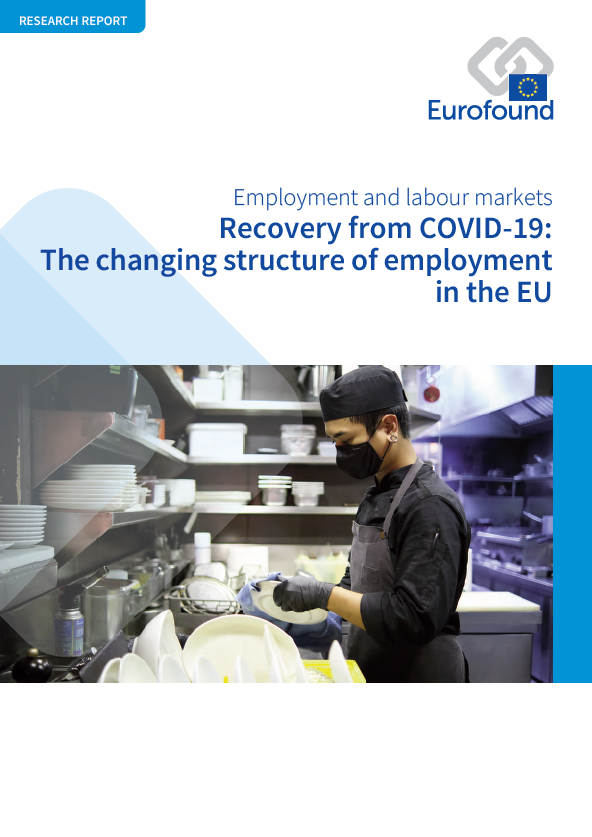
European labour markets have recovered strongly from COVID-19. By the end of 2021, little more than 18 months after the start of the pandemic, employment rates in the EU were almost at pre-crisis levels. This report summarises labour market developments in 2020 and 2021 using quarterly data from the EU Labour Force Survey. It does so from a structural perspective, with a focus on sector-level and occupation-level data, and key demographic variables: gender and age. Even if employment levels in EU Member States return to their pre-crisis levels, the composition of employment will have changed significantly. COVID-19 has accelerated some prior trends – occupational upgrading with increased employment in higher quality and higher paid jobs and the uptake of teleworking – in ways that are likely to leave a permanent mark on the structure of employment in the EU.
Key findings
The shock of COVID-19 to labour markets in 2020 was short and sharp, but the recovery has been swift, aided by policy interventions and significant public supports at national and EU level. Overall, EU employment levels recovered to pre-crisis levels within two years, compared to nearly eight years after the global financial crisis.
The recovery following the COVID-19 crisis has been very uneven across sectors. While employment in accommodation and food service activities, wholesale and retail trade, and transport registered a cumulative loss of 1.4 million workers between 2019 and 2021, the information and communications sector added 1 million jobs during the same period.
While the pandemic has accelerated some pre-existing structural trends such as digitalisation, it has also left enduring employment scars on the in-person service sectors which have been acutely hit by social distancing restrictions. Increasingly, for the first time in a generation, it is labour shortages rather than unemployment – labour supply rather than demand – that is emerging as a greater concern for policymakers.
Although job loss during the pandemic was concentrated in low-paid jobs, the recovery in employment levels during 2021 was driven by growth in well-paid jobs and occupations. Throughout the period 2019–2021, increases in well-paid employment have been greater among women than men in the EU27, while at the same time job loss has been most acute for women in low-paid jobs.
The rise in teleworking is likely to remain as the legacy of the COVID-19 crisis, with remote working continuing to grow in 2021 in nearly all EU Member States – even after the dramatic increase recorded at the start of the pandemic. The crisis has also favoured employment growth in sectors and occupations where telework is more feasible: between 2019 and 2021, information and communications technology (ICT) professional was the fastest growing occupation and the occupation with the highest share of teleworking in 2021.
The report contains the following lists of tables and figures
List of tables
- Table 1: Job vacancy rates, by sector, EU27, 2021 (%)
- Table 2: Year-on-year changes in employment levels and actual weekly hours worked, 2019–2021, EU27
- Table 3: Year-on-year changes in employment levels and weekly hours worked, by gender and age, 2020–2021, EU27
- Table 4: Year-on-year changes in employment levels and weekly hours worked for the 15–24 age group, by gender, Q4 2020–Q4 2021, EU27
- Table 5: Year-on-year changes in employment by gender and sector, Q4 2019–Q4 2021, EU27 (%)
- Table 6: Year-on-year changes in average number of actual weekly working hours, by age, gender and sector, Q4 2020–Q4 2021, EU27 (hours)
- Table 7: Main broad occupational trends in employment and hours year on year, Q4 2019–Q4 2020, EU27
- Table 8: Top three jobs with biggest employment gains and losses, Q4 2019–Q4 2021, EU27
List of figures
- Figure 1: Actual and trend estimates of employment levels among workers aged 15 and older, 2019–2020, EU27 (millions)
- Figure 2: People employed but not working, EU27 (percentage point difference from pre-COVID-19 baseline – same quarter in 2019)
- Figure 3: People employed but not working, by sector, Q4 2019–Q4 2021, showing peak incidence in Q2 2020, EU27 (%)
- Figure 4: Year-on-year changes in unemployment levels, by age, 2020–2021, EU27 (percentage points)
- Figure 5: Labour market slack, 2019–2020, EU27 (% of the extended labour force)
- Figure 6: Labour market slack, by country, Q4 2021, EU27 (percentage of the extended labour force)
- Figure 7: The components of labour market slack, by age and gender, Q4 2021 (percentage of the extended labour force)
- Figure 8: Transitions in labour market status, EU27, Q3 2021–Q4 2021 (million people)
- Figure 9: Net flows between employment and inactivity, by country and gender, Q3 2021–Q4 2021, EU27 (thousands)
- Figure 10: Employment shifts by job–wage quintile comparing the financial crisis (2008–2010) and the pandemic (Q4 2019–Q4 2021), EU27 (millions)
- Figure 11: Employment shifts by job–wage quintile, Q4 2019–Q4 2021, EU27 (millions)
- Figure 12: Employment shifts by job–wage quintile, by gender, Q4 2019–Q4 2021, EU27 (millions)
- Figure 13: Employment shifts, by job–wage quintile and broad sector, Q2 2019–Q4 2020, EU27 (millions)
- Figure 14: Employees working from home, by country, 2019–2021, EU27 (%)
- Figure 15: Employees working from home, by occupation, 2019–2021, EU27 (%)
- Figure 16: Change in employment, by occupation and teleworking incidence, Q4 2019–Q4 2021, EU27 (%)
- Figure 17: Employees working from home, by sector, 2019–2021, EU27 (%)
- Figure 18: Employees working from home, by gender, EU27
- Figure 19: Employees working from home, by gender and country, 2021, EU27 (%)
- Figure 20: Employees in teleworkable jobs, by gender and country, 2020, EU27 (%)
- Figure 21: Employees working from home, by age, 2016–2021, EU27 (%)
- Number of pages
-
46
- Reference nº
-
EF22022
- ISBN
-
978-92-897-2286-5
- Catalogue nº
-
TJ-09-22-521-EN-N
- DOI
-
10.2806/321685
- Permalink
Cite this publication
Eurofound (2022), Recovery from COVID-19: The changing structure of employment in the EU, Publications Office of the European Union, Luxembourg.
